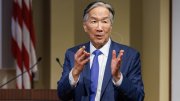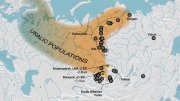"Korean scholars of Korean art consider our newly acquired Bamboo through the Four Seasons to be the most important Korean literati screen outside of Korea," says Robert D. Mowry delightedly. The Dworsky curator of Chinese art at the Arthur M. Sackler Museum and senior lecturer on Chinese and Korean art is thrilled with the piece himself, and with its acquisition.
 |
| Photograph courtesy of Harvard University Art Museums |
Bamboo through the Four Seasons is an eight-panel folding screen painted in ink on paper in the mid eighteenth century by Yu Tôk-chang. "Because Korean screens were used to divide larger rooms into smaller spaces, the number of panels varied to suit the size of the room," says Mowry. A screen may present a single, unified composition that spreads across all its panels, but in this instance each panel is conceived as an individual painting, two for each season. The first depicts newly sprung shoots emerging from the ground in spring. The last painting is shown here. It bears impressions of two seals, in red, that read Su-un and Ka-san-ûng, sobriquets of the artist.
Yu was a follower of the bamboo-painting master Yi Chông, who lived a century earlier, and both Yu and Yi took inspiration from earlier Chinese literati work ("literati" paintings being those done for the educated elite, as opposed to Buddhist or folk-art paintings). Their paintings depart in some respects from Chinese models, says Mowry. "Two tones of ink used to distinguish fore- and background subjects is a distinctly Korean style of bamboo painting." The snow in this wintry scene is the untouched paper on which the painting was made.
So important was the ability to paint bamboo that in the fifteenth century it outranked landscape painting in the examinations for Korea's royal academy. "Bamboo," says Mowry, "was one of the so-called Four Gentlemenalong with plum blossoms, orchids, and chrysanthemumsand all four were said to embody the virtues to which Confucian scholars aspired, such as integrity, purity, and strength in the face of adversity."





